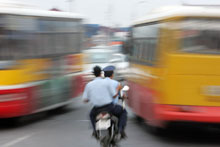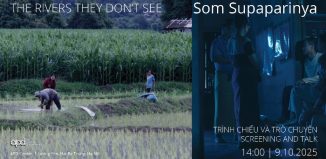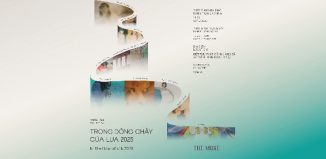KVT enjoys 2 photo exhibitions


KVT is impressed by the photos on display at Studio Tho and at Goethe. But the shows are closing soon so you will have to be quick to see if you agree that they are worth more than a single visit.
Studio Tho is one of those galleries that always manages to titillate and please the viewer. It’s an elegant little place with a distinctly high class European feel to it.
Tho’s latest exhibition is of rather gorgeous panoramic style photographs by exciting artist Nguyen Duc Tu. At first glance you tend to say “clever bunny!” but if you stay with them their real cleverness and thoughtful humor grabs you. This is hard to see on a milling opening night but creeps up on you when you have the chance to be alone with them.
In one obvious image the players are defying gravity and in another a girl is carrying a surf board across a non busy Saigon intersection (three distinct double takes). Other frozen moments to look out for are the swarthy European or middle eastern looking gunmen at an engagement procession in Hanoi…and aren’t some of the nubile virgins bearing gifts blonde and nordic? And ,hey, isn’t it a role reversal? And is someone on a balcony daring to pour water over a gangsters head?
The floating dancers in one are gorgeous and then you spy the little boy urinating in a dark corner. Is the girl with balloons tethered against her will or is she giving come and see me invitations? Perhaps my favorite is the one where you don’t know if you’re the viewer or the subject.
The video installation on opening night was worth seeing too but it’s the photographs with their spot the quirky bits in their beautifully elongated and romantically posed urban scenes that are worth a trip or two to Ma May St. Mind you the views in that tawdry tourist strip are calling out for an equally clever photographer with an eye for dramatic irony.
Visual Invisibility at Goethe

It’s taken a while and a couple of visits and a few discussions with other viewers before I decided to comment on this important exhibition. Any serious photographer worth their salt is aware of the work of German photographer Peter Bialobrzeski. If you ever have an opportunity to see his large scale photographs you’ll be blown away. His photographic books are fabulously beautiful.
His images of the mega cities of Asia seen in Neon Tigers and of the transformation of urban wastelands in Lost in Transition are internationally acclaimed. But if anyone has the impression that he is specifically an urban specialist they should see his Heimat landscapes which are like glorious romantic paintings.
Mapping Invisible Cities is the result of educational workshops conducted by Bialobrzeski in 6 South East Asian mega cities (which I guess Hanoi is aspiring to be) 26 photographers explored their cities, obviously using the master’s conceptual approach, and one resulting exhibition is at Goethe. The works have obviously been traveling around lot and some show signs of wear but this doesn’t detract from the show.
Perhaps it’s a good idea for the viewer to begin with Bialobrzeski’s 6 photographs taken in each city on the far wall and then go on a slow walk around the virtual city that the combined works represent. It’s a fascinating tour of the often invisible aspects of the modern urbanopolis and your glance takes in grand architecture, the detritus of urban sprawl, the transition zones between slum and glitz, and importantly and poignantly, the poorer human players who usually are the most invisible even when they are the most prevalent.
Although the viewer is asked to take on this city as its own entity you of course are drawn to the Vietnamese component. Here we see the invisible players that make up the swirl and chaos of the traffic rush; the appalling, temporary yet poignant accommodation of invisible migrant construction workers; and the farmers posed in magnificent but ultimately futile portraits against encroaching industrial estates that will soon render them even more invisible and very disposable.
To take a tour of the city is to have your own mini educational workshop in what makes up good photography. The use of light, and the waiting for just the right amount of light is paramount here, and the juxtaposition between the photograph as a painting with light and a social documentary is important.
I don’t think we’ll have another photography exhibition in Hanoi for a while that will rival this one. Like a lot of us, I hope that Goethe continues with its presentation of good photography. All of us who fancy ourselves as cameramen need the occasional exhilaration that comes with exposure to thoughtful and excellently selected work.
Definitely an exhibition not to be missed but be quick as it closes on 23rd. ![]()
| Not a reviewer, not a critic, “Kiếm Văn Tìm” is an interested, impartial and informed observer and connoisseur of the Hanoi art scene who offers highly opinionated remarks and is part of the long and venerable tradition of anonymous correspondents. Please add your thoughts in the comment field below. |













